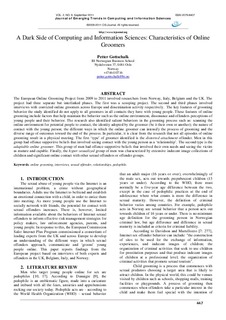| dc.contributor.author | Gottschalk, Petter | |
| dc.date.accessioned | 2011-12-14T12:09:37Z | |
| dc.date.available | 2011-12-14T12:09:37Z | |
| dc.date.issued | 2011 | |
| dc.identifier.issn | 2079-8407 | |
| dc.identifier.issn | 2218-6301 | |
| dc.identifier.uri | http://hdl.handle.net/11250/93384 | |
| dc.description | Published in an Open Access Journal. Available from http://www.cisjournal.org | no_NO |
| dc.description.abstract | The European Online Grooming Project from 2009 to 2011 involved researchers from Norway, Italy, Belgium and the UK. The project had three separate but interlinked phases. The first was a scooping project. The second and third phases involved interviews with convicted online groomers across Europe and dissemination activity respectively. The key features of grooming behavior the study identified do not apply to all groomers in all contacts they have with young people. These features of online grooming include factors that help maintain the behavior such as the online environment, dissonance and offenders perceptions of young people and their behavior. The research also identified salient behaviors in the grooming process such as: scanning the online environment for potential people to contact, the identity adopted by the groomer (be it their own or another); the nature of contact with the young person; the different ways in which the online groomer can intensify the process of grooming and the diverse range of outcomes toward the end of the process. In particular, it is clear from the research that not all episodes of online grooming result in a physical meeting. The first ‘type’ of groomer identified is the distorted attachment offender. Men in this group had offence supportive beliefs that involved seeing contact with the young person as a ‘relationship’. The second type is the adaptable online groomer. This group of men had offence supportive beliefs that involved their own needs and seeing the victim as mature and capable. Finally, the hyper-sexualized group of men was characterized by extensive indecent image collections of children and significant online contact with other sexual offenders or offender groups. | no_NO |
| dc.language.iso | eng | no_NO |
| dc.publisher | CIS Journal / ARPN Publishers | no_NO |
| dc.relation.uri | http://cisjournal.org/journalofcomputing/Download_September_pdf_5.aspx | |
| dc.subject | online grooming | no_NO |
| dc.subject | interviews | no_NO |
| dc.subject | sexual offender | no_NO |
| dc.subject | pedophile | no_NO |
| dc.title | A Dark Side of Computing and Information Sciences: Characteristics of Online Groomers | no_NO |
| dc.type | Journal article | no_NO |
| dc.type | Peer reviewed | no_NO |
| dc.source.pagenumber | 447-455 | no_NO |
| dc.source.volume | 2 | no_NO |
| dc.source.journal | Journal of Emerging Trends in Computing and Information Sciences | no_NO |
| dc.source.issue | 9 | no_NO |
